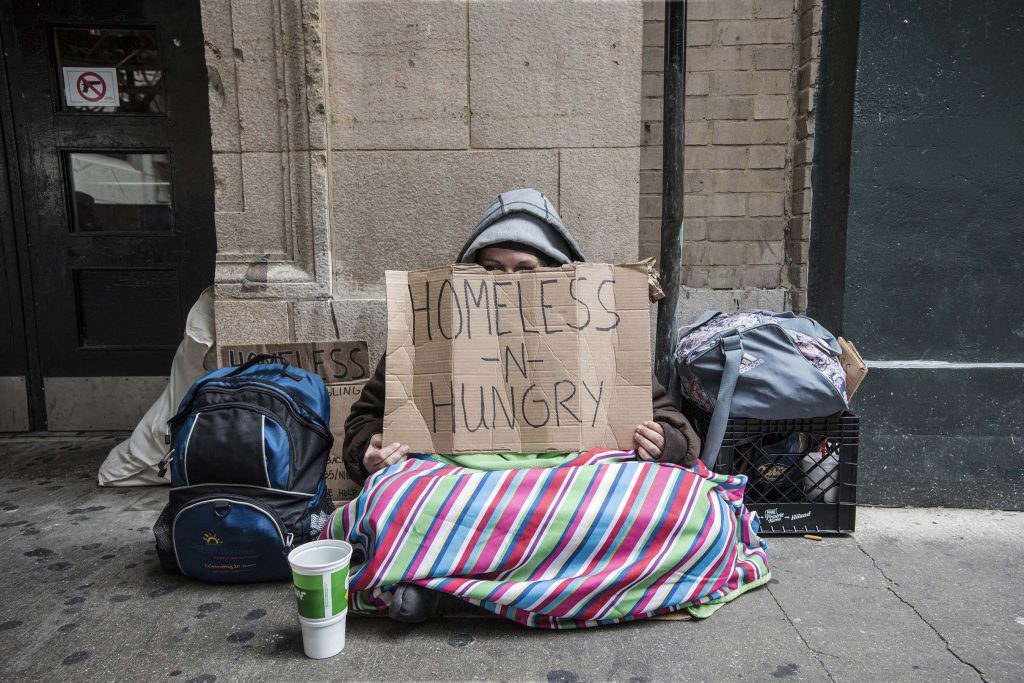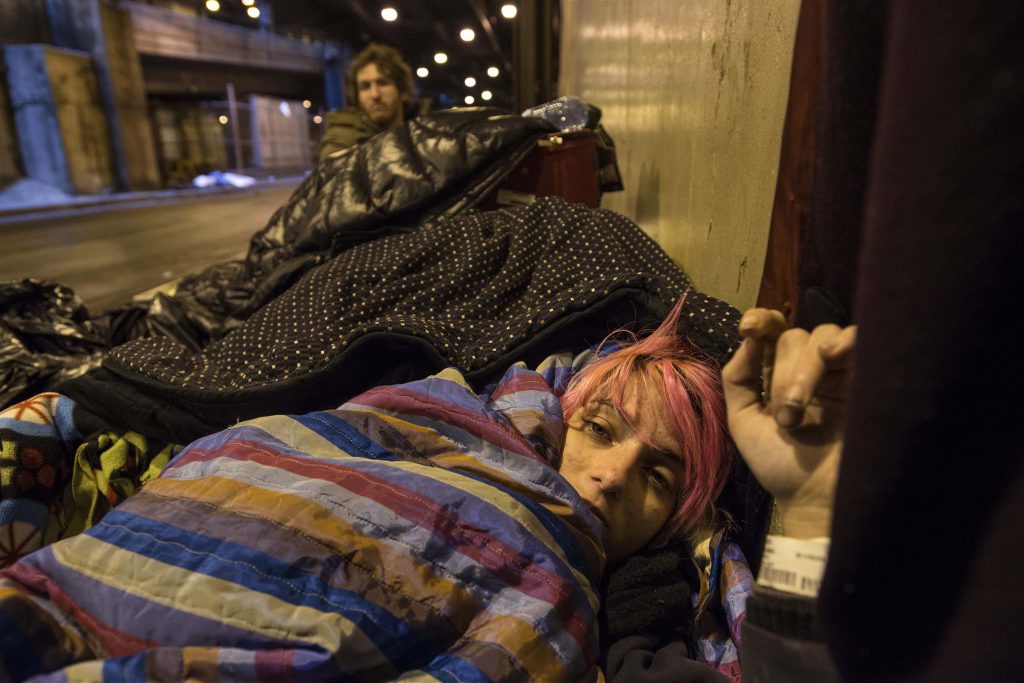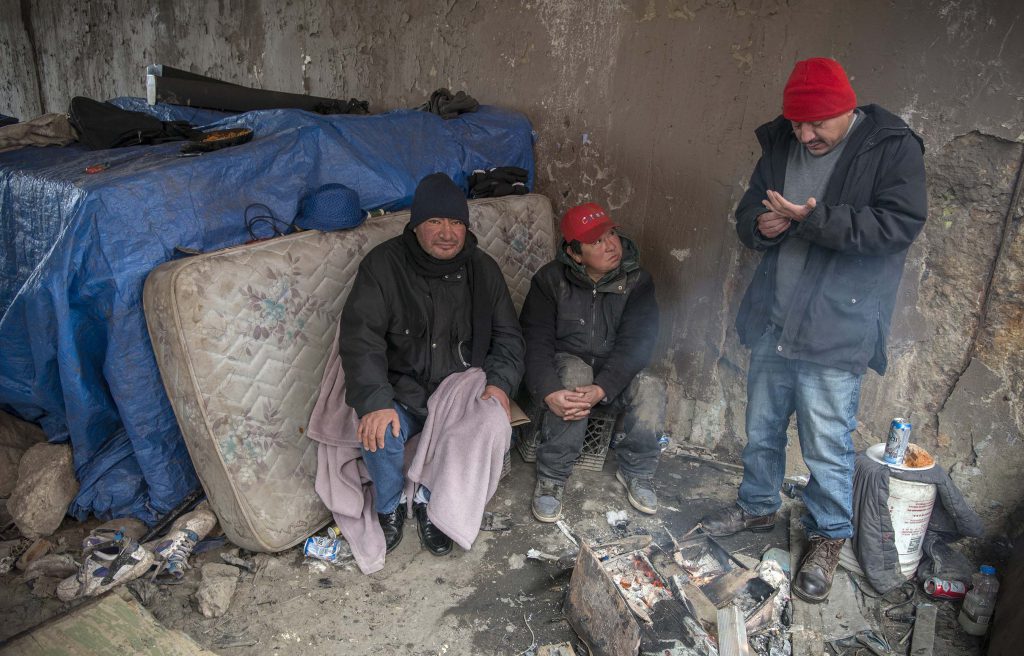By Mary Hall
Medill Reports
On a late summer day that just hints at the coming fall, Kelly, 38, greets me with a smile as bright as the colorful, striped blanket she often has draped over her while she busks for money just outside a busy downtown train stop.

She’s been living on Chicago’s streets for the last two years with her husband and she is just over 5-months pregnant. A former drug user, she’s now on methadone, used to suppress heroine withdrawal symptoms, to protect her baby. That day, wrapped in a warm sweatshirt and sitting on cardboard, the cold wasn’t a problem.
But it became one. I saw her frequently as temperatures dropped over these last weeks and months.
“When you’re [outside] at nighttime, laying down … I could be wrapped up in my blankets, have my jackets on and it’s too cold to fall asleep,” Kelly said. “I’m just praying to fall asleep, and it’s too cold to even try to fall asleep.Like many of the homeless who live downtown, spots to keep warm during a cold winter day are fairly accessible. Warming centers open in the city, usually when it gets below 32 degrees, said Christina Villarreal, director of communications for the Department of Family and Support Services. Most are libraries, police stations or community centers. But they close sometime between 5 and 8 p.m.
“It worries us,” Chris said, a homeless man addicted to opioids, who can often be found near Union Station with his wife. “How cold is it going to get? Where are we going to go?”
There are 5,450 people counted as homeless this year in town, with 1,357 people found outside of a shelter, according to the City of Chicago’s most recent Homeless Point-in-Time Count & Survey Report, conducted in January 2018. Seventy percent of those without shelter said they would either stay outside or ride on CTA trains.
Although there are more homeless people living in shelters, survey data shows that an extremely high percentage of unsheltered people are male (84 percent) and black (74 percent).
Thirty-five percent of the unsheltered people have received services for substance abuse, 29 percent have received mental health services, and 30 percent have physical disabilities, the report states. According to 2017 data, 25 percent have experienced domestic violence in the past.
Some 86 libraries and community centers throughout the city double as warming centers during the day for people who live in shelters, outdoors or can’t afford to heat their homes.
But it’s after 8 p.m., when the centers close, that finding places to keep warm becomes difficult. The earliest don’t open until 8:30 a.m., leaving people to confront more than 12 hours of cold.
“When it’s cold or raining, we usually go to the trains,” Kelly said. “But I still hate the train because you’re constantly moving, bouncing all around and you can’t really sleep.”
One major snowstorm has already hit Chicago this fall, and some forecasters are predicting several more this winter. And while temperatures can plummet anytime of the day, it often feels coldest in the early hours of the day, just before dawn.
If people are in need of emergency shelters, “we usually tell people is to call 311, because they have the extensive list of hospitals and shelters,” Villarreal said. The city does not publicly release locations of shelters, to keep people from showing up at locations where beds are not available.

The nine emergency shelters in Chicago provide a place to sleep for one night at a time, choosing people by lottery when there aren’t enough beds to go around. Here, people who visit can sometimes find opportunities for more permanent housing solutions, but many are only available to those who can prove they are drug-free or have long waiting lists.
Chronically-homeless, Kelly and her husband say they only choose to go to a shelter if they have made enough asking for money on the street that day. People have to arrive at most shelters by 7 p.m. in order to get a bed. Since Kelly and her husband make most of their money between 4 to 8 p.m., they usually can’t make it to a shelter in time.
If they do decide to try for a shelter, their options are limited. According to the same analysis, nine emergency shelters — which the city partially funds — are available to those who are chronically homeless. Six of the nine shelters only serve youth or families. One only serves men. Two serves both men and women, but if there are more people than available beds, the people who get beds are chosen by lottery.
“I will only stay if [my husband] gets a bed, too,” Kelly said. “I need to know that he is safe, and he needs to know that I’m safe.”

If Kelly and her husband don’t get a spot in a shelter, they have two other potential choices, Kelly says. Northwestern Memorial Hospital offers a warming center, where people can sit up overnight. With only about 25 chairs available here through, and the couple has to be in line by 9 p.m. or they won’t get a seat, she added.
The city has opened an overnight warming center, what Kelly describes as an open gym-like room where about 50 people can find a spot to lay down. However, the odor and atmosphere is extremely unpleasant, Kelly said.

Others describe emergency centers and shelters as harboring bed bugs, dirty or overcrowded, which can leads to fights. As Bud, a homeless man who also lives downtown, described it, “It’s one little box. It’s bound to kick off,” he said of the one-room overnight warming centers where people can sit. Shelters are the places that offer beds.
Still, it’s the prolonged exposure to cold that many find hard to endure.
“It’s being outside more than five hours a day,” Bud said. The question on his mind constantly during the winter: “Where am I going to go to get warm?”


